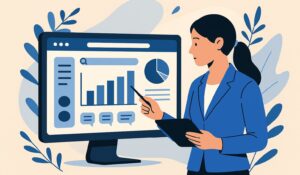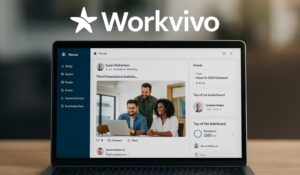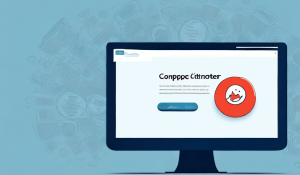Resilience in the workplace isn’t just a buzzword. It’s a necessity. Especially in today’s fast-paced work environment, employees are constantly facing deadlines, organizational changes, and emotional challenges. Building resilience at work helps individuals stay calm, positive, and productive.
In fact, resilience in the workplace plays a key role in keeping teams aligned and mentally strong. When employees are resilient, they adapt faster and work smarter. And let’s face it, challenges are never-ending. That’s why building resilience at work is no longer optional—it’s critical.
Understanding how to build resilience is the first step toward healthier teams. The more prepared your people are emotionally and mentally, the better they perform under pressure. Whether it’s handling tough feedback or unexpected changes, resilience strategies help smooth the ride.
Let’s Break It Down: What is Workplace Resilience?
Workplace resilience means having the ability to bounce back. It’s the strength that keeps employees going when things get tough. From missed targets to team conflicts, resilient professionals face it all with a clear mind and steady pace.
Rather than falling apart, resilient employees reset quickly. They look for solutions instead of dwelling on problems. It’s about mental flexibility and emotional strength. And yes, it’s something that can be built over time.
How to Build Resilience Without Burning Out
So how do you actually start building resilience? Start small. Here are some simple steps:
- Encourage open conversations.
- Promote mental well-being through breaks.
- Offer employee support programs.
- Reward flexible problem-solving.
- Allow room for failure without judgment.
These daily actions help people feel safe and supported. That’s the perfect recipe for growing stronger together.
The 5 Pillars of Building Resilience in the Workplace
Creating a resilient workplace environment doesn’t happen by accident. It requires intentional effort across multiple dimensions:
1. Psychological Safety First
Teams that feel safe sharing ideas, concerns, and even failures develop stronger resilience muscles. When employees know they won’t face ridicule or punishment for honest mistakes, they’re more willing to take smart risks and communicate openly.
Psychological safety forms the foundation of building resilience at work because it creates an environment where:
- Team members can acknowledge challenges without fear
- Ideas flow freely, leading to innovative solutions
- Feedback becomes constructive rather than threatening
- Mistakes transform into valuable learning opportunities
2. Clear Communication Channels
Resilient workplaces maintain transparency, especially during difficult times. When leadership communicates honestly about challenges and changes, employees feel respected and included in the process.
Effective communication strategies include:
- Regular team check-ins that address both successes and obstacles
- Multiple channels for sharing information (digital platforms, in-person meetings)
- Consistent messaging that acknowledges realities while maintaining optimism
- Two-way feedback systems that ensure all voices are heard
3. Adaptable Work Structures
The ability to pivot quickly when circumstances change is a hallmark of resilient organizations. This flexibility might mean:
- Adjustable work schedules that accommodate personal needs
- Cross-training team members to handle various responsibilities
- Streamlined processes that can scale up or down as needed
- Technology systems that support remote, hybrid, and in-office work
4. Meaningful Recognition Systems
Recognition doesn’t always mean financial rewards—sometimes acknowledgment of effort and impact matters most. However, well-structured employee rewards programs can significantly boost resilience by providing tangible appreciation for exceptional performance during challenging times.
Effective recognition approaches include:
- Timely appreciation for extra effort during challenging periods
- Public acknowledgment of problem-solving and innovation
- Peer-to-peer recognition programs that build community
- Celebration of both individual and team achievements
5. Continuous Learning Culture
Resilience thrives when people continuously develop new skills and knowledge. Organizations that invest in talent development opportunities signal their commitment to employee growth while simultaneously building workplace resilience.
Building resilience through learning involves:
- Comprehensive employee training programs relevant to evolving industry demands help build both technical competence and emotional resilience.
- Leadership development at all organizational levels
- Cross-departmental knowledge sharing
- Time allocated specifically for professional development
Common Roadblocks to Building Resilience
Even with the best intentions, some teams struggle to grow their resilience. Here are a few common barriers:
- Lack of managerial support
- A blame-first culture
- Poor communication
- No feedback or recognition systems
- Burnout due to poor work-life balance
Removing these roadblocks is the key to creating lasting change.
Resilience Strategies That Actually Work
Looking for practical resilience strategies? Here are some that make a real impact:
- Use employee pulse surveys to check emotional health
- Provide consistent feedback through recognition platforms
- Allow peer-to-peer praise
- Share stories of recovery and learning during team meetings
- Train managers in empathetic leadership
These simple habits can reshape your entire work culture.
Why Managers Play a Key Role in Building Resilience
Managers hold the power to make or break resilience. Their mindset trickles down to the entire team. A supportive manager can turn a stressful project into a growth opportunity.
- Encourage transparency
- Show empathy during 1:1s
- Avoid micromanagement
- Celebrate small wins regularly
All these actions directly influence how employees deal with pressure.
Creating a Resilient Culture from the Inside Out
A resilient workplace doesn’t just happen. It’s a culture built over time. Leaders must:
- Align policies with employee well-being
- Invest in mental health tools
- Make recognition a daily habit
- Encourage flexibility and trust
If these values become part of your daily workflow, resilience becomes second nature.
What Employees Can Do to Strengthen Their Own Resilience
While companies play a big role, individual actions matter too. Employees can:
- Stay self-aware and practice mindfulness
- Build support networks within the team
- Set realistic expectations
- Reflect on what went well after setbacks
Building resilience isn’t just about powering through—it’s about learning to reset smartly.
Team Activities That Help in Building Resilience
Want a fun way to build team resilience? Try these group activities:
- Role-play problem-solving situations
- Host monthly gratitude circles
- Arrange storytelling sessions of challenges and wins
- Create recognition leaderboards and implement creative employee recognition ideas
These keep morale high and minds sharp.
How Resilience in the Workplace Drives Long-Term Success
When resilience is part of the company’s DNA, it impacts everything:
- Reduced turnover
- Proven strategies to increase employee engagement through resilience-building activities that make teams more connected and motivated.
- Higher productivity
- Improved innovation
Resilient teams don’t just survive; they stand out. They carry the company forward with strength.
Real-World Resilience in the Workplace: Success Stories
Global Tech Company Transforms After Market Crash
When a major market downturn hit the tech sector, CompuTech (name changed) faced potential layoffs and restructuring. Instead of panicking, leadership implemented resilience strategies including:
- Daily transparency meetings with all team members
- Skill-sharing sessions where employees taught each other new abilities
- Temporary role reassignments to address changing market needs
- Wellness resources to help manage stress
The result? Despite industry-wide layoffs of 15%, CompuTech retained 98% of its workforce and emerged stronger when the market recovered.
Healthcare Provider Navigates Pandemic Pressure
When a regional healthcare network faced unprecedented demands during a public health crisis, burnout seemed inevitable. Their resilience approach included:
- Rotating schedules to prevent exhaustion
- Peer support groups facilitated by mental health professionals
- Recognition programs that acknowledged extraordinary efforts
- Streamlined processes that reduced administrative burden
Their efforts resulted in staff retention rates 23% higher than industry averages during a period when healthcare worker shortages reached crisis levels.
How HubEngage Makes Building Resilience a Breeze
Resilience starts with clear, consistent communication. HubEngage’s powerful communication tools ensure employees stay connected, aligned, and supported, no matter the challenge.
HubEngage is the one-stop solution for companies serious about building resilience at work. With features like:
- Automated employee recognition
- Real-time feedback tools
- Survey and pulse checks
- Gamified Engagement
You create a safe, supportive, and motivating culture in no time.
The HubEngage platform integrates seamlessly with your existing systems and helps you act on real-time data. It’s not just about managing work—it’s about improving how people feel while doing it.
Implementing Resilience with HubEngage: A Step-by-Step Approach
Organizations looking to strengthen workplace resilience can follow this proven implementation process:
1. Assessment
Begin with a comprehensive resilience assessment using HubEngage’s specialized survey tools. This establishes your baseline across key dimensions including:
- Communication effectiveness
- Employee engagement levels
- Recognition program impact
- Learning culture maturity
- Change readiness indicators
2. Strategy Development
Based on assessment results, develop a tailored resilience strategy that addresses specific organizational needs. HubEngage’s strategy templates provide frameworks for:
- Short-term resilience wins (1-3 months)
- Medium-term capability building (3-9 months)
- Long-term culture transformation (9+ months)
3. Platform Configuration
Customize the HubEngage platform to support your unique resilience requirements:
- Communication channel preferences
- Recognition program structure
- Learning module selection
- Feedback mechanism design
- Analytics dashboard configuration
4. Phased Implementation
Roll out your resilience initiative in manageable phases:
- Leadership orientation and training
- Champion identification and development
- Department-by-department activation
- All-employee engagement activities
5. Continuous Improvement
Use HubEngage’s analytics to track progress and refine your approach:
- Monthly progress reviews
- Quarterly strategy adjustments
- Annual comprehensive assessments
- Ongoing platform optimization
Measuring Your Resilience ROI
With HubEngage’s analytics capabilities, organizations can track the business impact of their resilience initiatives. Key metrics to consider include:
People Metrics
- Retention rates
- Absenteeism reduction
- Internal promotion percentages
- Employee satisfaction scores
Performance Metrics
- Productivity measurements
- Project completion rates
- Innovation metrics (new ideas generated)
- Customer satisfaction trends
Financial Metrics
- Recruitment cost savings
- Training ROI
- Revenue per employee
- Overall profitability improvements
Summing up: Resilience as Your Organizational Superpower
In an unpredictable business environment, resilience in the workplace has become the defining characteristic of successful organizations. By implementing the right strategies with HubEngage’s specialized platform, companies can transform challenges into opportunities while creating more sustainable, engaging work environments.
Remember that resilience isn’t created overnight—it’s developed through consistent practices and supportive systems. With HubEngage as your partner, the journey toward greater organizational resilience becomes clearer, more measurable, and ultimately more successful.
Start building your resilience advantage today by contacting HubEngage’s , book a demo with HubEngage today.
And don’t forget to check out our employee engagement platform that’s trusted by businesses worldwide.
Because when it comes to resilience in the workplace, HubEngage is your smartest choice.













